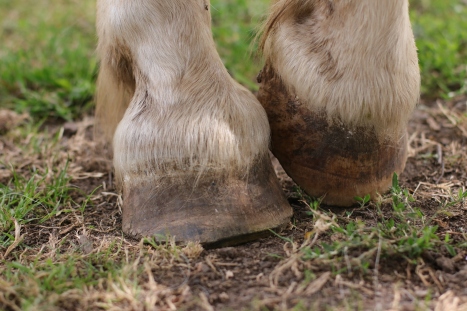This is a question that a lot of horse owners who are interested in taking their horses barefoot end up asking themselves. Google it and you will find countless articles and forum threads, and most of them will come to different conclusions.
All of this makes it very confusing when you just want a simple answer as to why your horse isn’t comfortable and what you can do about it.
In my experience, it boils down to two things: time and management.
Firstly: time. How long has your horse been barefoot? A barefoot lifestyle is quite different to the way most horses are kept, especially in the UK. It relies on building the hoof from the inside out. Think about how long it takes to grow a completely new toenail after you’ve bruised it – a hoof is no different. You might want to consider preparing your horse to go barefoot before you take their shoes off.
I briefly mentioned developing callused feet in a previous post, and this is something that I think a lot of people don’t give enough time to. The foot needs stimulation (i.e. wear) before it will respond by toughening up and it can take a while for that toughness to develop.
This brings me on to the other reason why horses become footsore: management. Giving your horse all the time in the world is pointless if you aren’t also providing the building blocks for them to develop strong feet.
A high-sugar diet is a key factor in horses displaying footiness, as it triggers the onset of laminitic symptoms. To avoid this, check what your horse is eating. Check everything, from hard feed, to hay, to grass and forage. Sugar hides in all sorts of food. Ryegrass (the grazing available to most horses in the UK) is a major culprit in causing footiness in horses, and creates ideal conditions for diseases such as laminitis.
Regular turnout or some form of exercise is also essential. Movement is what kickstarts the callusing process, especially movement over hard surfaces like gravel and tarmac. Allowing your horse time to ‘practise’ walking on these types of surfaces without the aid of shoes gives them a chance to develop their feet at their own pace. These are new sensations and it will take a horse time to get used to them. They definitely won’t be able to adapt if they’re expected to behave like everything feels the same as always.

These feet aren’t the prettiest, but they are completely functional.
Making sure your horse has access to plenty of different surfaces is also vital. If you and your horse can do it, steady roadwork is an excellent way to get used to being barefoot. The flat surface means the horse is less likely to stand on something sharp and get a bruise, and you get the bonus of increased wear, which is the first step towards self-trimming.
Many people have tried to take the shoes off their horses and have watched them struggle to transition; a distressing experience for any horse owner. There are many possible explanations for why a horse might find it difficult to adapt to being barefoot, but I think it’s exceedingly rare for the feet to be so damaged beyond repair that they will never be able to support the horse without the aid of shoe.
